Contract Law Case Study: Analyzing Contractual Terms and Agreements
VerifiedAdded on 2023/06/07
|6
|1836
|323
Case Study
AI Summary
This assignment presents a comprehensive case study analyzing several contract law scenarios. The first scenario examines whether Weitao is liable under an exclusion clause in a hire agreement, concluding he is not due to lack of reasonable notice. The second scenario assesses Evelyn's potential breach of an oral agreement with Warren, determining she is liable for damages. The third scenario explores whether a representation about a tablet's storage space constitutes a contractual term, concluding it does. Finally, the fourth scenario investigates whether a laptop charger should be considered an implied term in a hire agreement, asserting that it is and Evelyn is in breach. Desklib offers students access to a wide range of solved assignments and past papers for academic support.
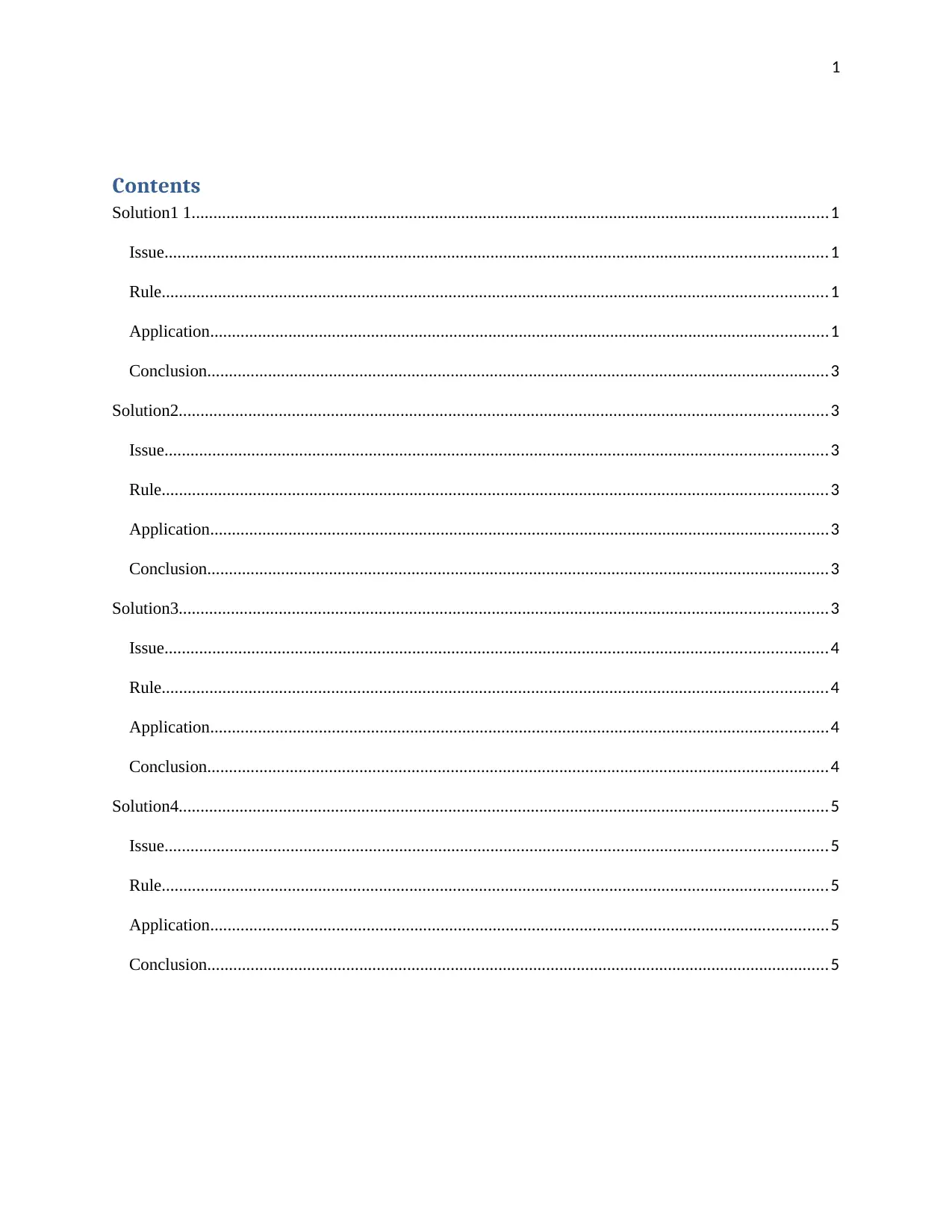
1
Contents
Solution1 1..................................................................................................................................................1
Issue........................................................................................................................................................1
Rule.........................................................................................................................................................1
Application..............................................................................................................................................1
Conclusion...............................................................................................................................................3
Solution2.....................................................................................................................................................3
Issue........................................................................................................................................................3
Rule.........................................................................................................................................................3
Application..............................................................................................................................................3
Conclusion...............................................................................................................................................3
Solution3.....................................................................................................................................................3
Issue........................................................................................................................................................4
Rule.........................................................................................................................................................4
Application..............................................................................................................................................4
Conclusion...............................................................................................................................................4
Solution4.....................................................................................................................................................5
Issue........................................................................................................................................................5
Rule.........................................................................................................................................................5
Application..............................................................................................................................................5
Conclusion...............................................................................................................................................5
Contents
Solution1 1..................................................................................................................................................1
Issue........................................................................................................................................................1
Rule.........................................................................................................................................................1
Application..............................................................................................................................................1
Conclusion...............................................................................................................................................3
Solution2.....................................................................................................................................................3
Issue........................................................................................................................................................3
Rule.........................................................................................................................................................3
Application..............................................................................................................................................3
Conclusion...............................................................................................................................................3
Solution3.....................................................................................................................................................3
Issue........................................................................................................................................................4
Rule.........................................................................................................................................................4
Application..............................................................................................................................................4
Conclusion...............................................................................................................................................4
Solution4.....................................................................................................................................................5
Issue........................................................................................................................................................5
Rule.........................................................................................................................................................5
Application..............................................................................................................................................5
Conclusion...............................................................................................................................................5
Paraphrase This Document
Need a fresh take? Get an instant paraphrase of this document with our AI Paraphraser
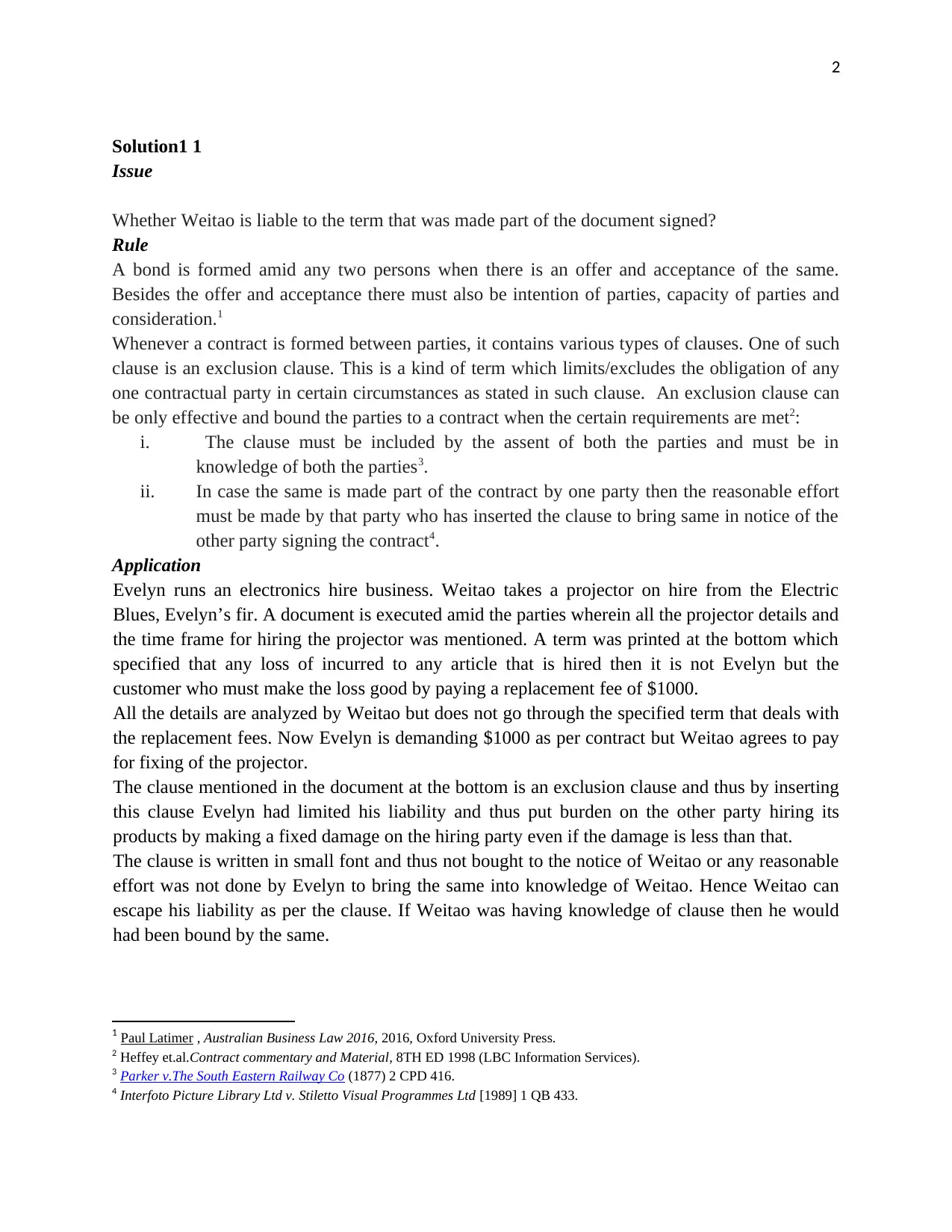
2
Solution1 1
Issue
Whether Weitao is liable to the term that was made part of the document signed?
Rule
A bond is formed amid any two persons when there is an offer and acceptance of the same.
Besides the offer and acceptance there must also be intention of parties, capacity of parties and
consideration.1
Whenever a contract is formed between parties, it contains various types of clauses. One of such
clause is an exclusion clause. This is a kind of term which limits/excludes the obligation of any
one contractual party in certain circumstances as stated in such clause. An exclusion clause can
be only effective and bound the parties to a contract when the certain requirements are met2:
i. The clause must be included by the assent of both the parties and must be in
knowledge of both the parties3.
ii. In case the same is made part of the contract by one party then the reasonable effort
must be made by that party who has inserted the clause to bring same in notice of the
other party signing the contract4.
Application
Evelyn runs an electronics hire business. Weitao takes a projector on hire from the Electric
Blues, Evelyn’s fir. A document is executed amid the parties wherein all the projector details and
the time frame for hiring the projector was mentioned. A term was printed at the bottom which
specified that any loss of incurred to any article that is hired then it is not Evelyn but the
customer who must make the loss good by paying a replacement fee of $1000.
All the details are analyzed by Weitao but does not go through the specified term that deals with
the replacement fees. Now Evelyn is demanding $1000 as per contract but Weitao agrees to pay
for fixing of the projector.
The clause mentioned in the document at the bottom is an exclusion clause and thus by inserting
this clause Evelyn had limited his liability and thus put burden on the other party hiring its
products by making a fixed damage on the hiring party even if the damage is less than that.
The clause is written in small font and thus not bought to the notice of Weitao or any reasonable
effort was not done by Evelyn to bring the same into knowledge of Weitao. Hence Weitao can
escape his liability as per the clause. If Weitao was having knowledge of clause then he would
had been bound by the same.
1 Paul Latimer , Australian Business Law 2016, 2016, Oxford University Press.
2 Heffey et.al.Contract commentary and Material, 8TH ED 1998 (LBC Information Services).
3 Parker v.The South Eastern Railway Co (1877) 2 CPD 416.
4 Interfoto Picture Library Ltd v. Stiletto Visual Programmes Ltd [1989] 1 QB 433.
Solution1 1
Issue
Whether Weitao is liable to the term that was made part of the document signed?
Rule
A bond is formed amid any two persons when there is an offer and acceptance of the same.
Besides the offer and acceptance there must also be intention of parties, capacity of parties and
consideration.1
Whenever a contract is formed between parties, it contains various types of clauses. One of such
clause is an exclusion clause. This is a kind of term which limits/excludes the obligation of any
one contractual party in certain circumstances as stated in such clause. An exclusion clause can
be only effective and bound the parties to a contract when the certain requirements are met2:
i. The clause must be included by the assent of both the parties and must be in
knowledge of both the parties3.
ii. In case the same is made part of the contract by one party then the reasonable effort
must be made by that party who has inserted the clause to bring same in notice of the
other party signing the contract4.
Application
Evelyn runs an electronics hire business. Weitao takes a projector on hire from the Electric
Blues, Evelyn’s fir. A document is executed amid the parties wherein all the projector details and
the time frame for hiring the projector was mentioned. A term was printed at the bottom which
specified that any loss of incurred to any article that is hired then it is not Evelyn but the
customer who must make the loss good by paying a replacement fee of $1000.
All the details are analyzed by Weitao but does not go through the specified term that deals with
the replacement fees. Now Evelyn is demanding $1000 as per contract but Weitao agrees to pay
for fixing of the projector.
The clause mentioned in the document at the bottom is an exclusion clause and thus by inserting
this clause Evelyn had limited his liability and thus put burden on the other party hiring its
products by making a fixed damage on the hiring party even if the damage is less than that.
The clause is written in small font and thus not bought to the notice of Weitao or any reasonable
effort was not done by Evelyn to bring the same into knowledge of Weitao. Hence Weitao can
escape his liability as per the clause. If Weitao was having knowledge of clause then he would
had been bound by the same.
1 Paul Latimer , Australian Business Law 2016, 2016, Oxford University Press.
2 Heffey et.al.Contract commentary and Material, 8TH ED 1998 (LBC Information Services).
3 Parker v.The South Eastern Railway Co (1877) 2 CPD 416.
4 Interfoto Picture Library Ltd v. Stiletto Visual Programmes Ltd [1989] 1 QB 433.
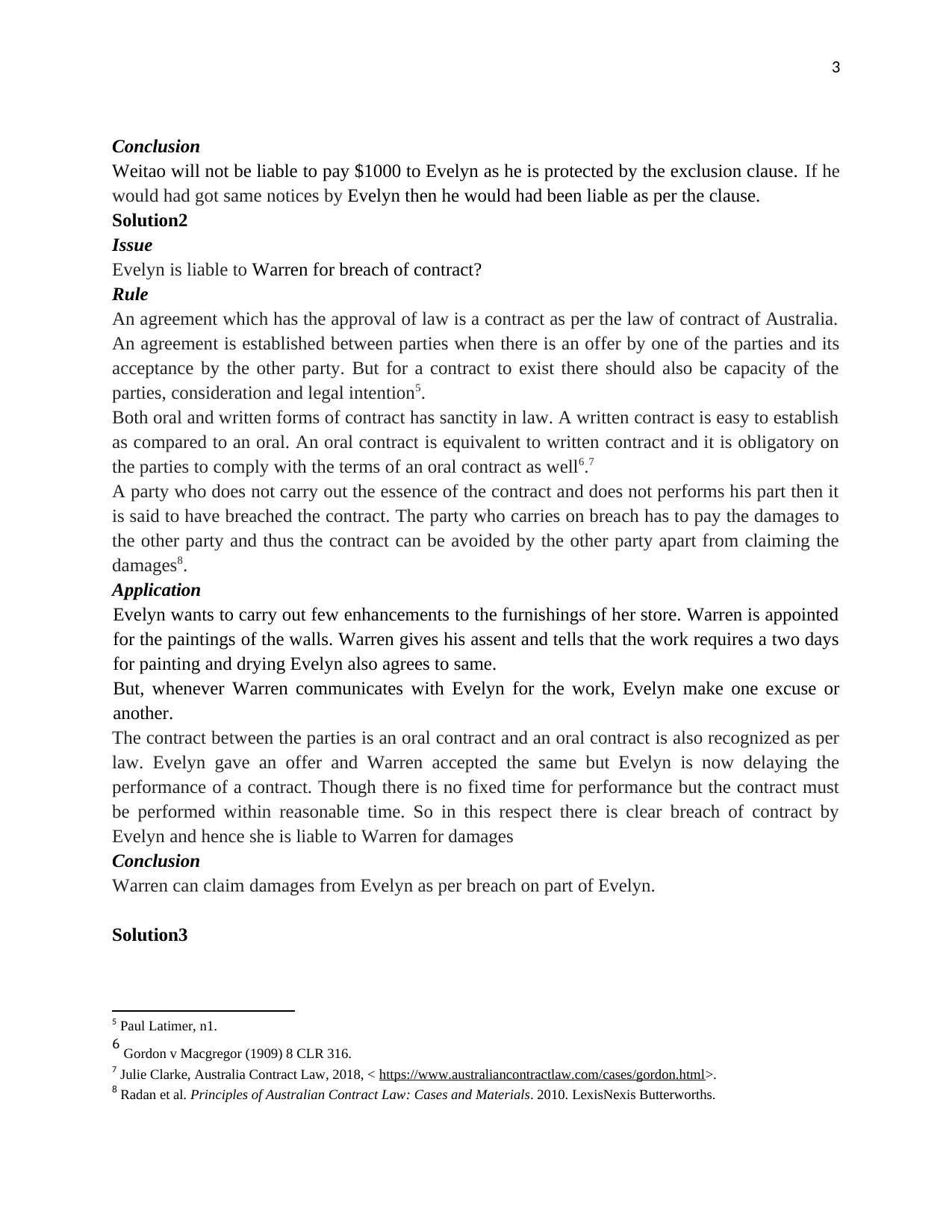
3
Conclusion
Weitao will not be liable to pay $1000 to Evelyn as he is protected by the exclusion clause. If he
would had got same notices by Evelyn then he would had been liable as per the clause.
Solution2
Issue
Evelyn is liable to Warren for breach of contract?
Rule
An agreement which has the approval of law is a contract as per the law of contract of Australia.
An agreement is established between parties when there is an offer by one of the parties and its
acceptance by the other party. But for a contract to exist there should also be capacity of the
parties, consideration and legal intention5.
Both oral and written forms of contract has sanctity in law. A written contract is easy to establish
as compared to an oral. An oral contract is equivalent to written contract and it is obligatory on
the parties to comply with the terms of an oral contract as well6.7
A party who does not carry out the essence of the contract and does not performs his part then it
is said to have breached the contract. The party who carries on breach has to pay the damages to
the other party and thus the contract can be avoided by the other party apart from claiming the
damages8.
Application
Evelyn wants to carry out few enhancements to the furnishings of her store. Warren is appointed
for the paintings of the walls. Warren gives his assent and tells that the work requires a two days
for painting and drying Evelyn also agrees to same.
But, whenever Warren communicates with Evelyn for the work, Evelyn make one excuse or
another.
The contract between the parties is an oral contract and an oral contract is also recognized as per
law. Evelyn gave an offer and Warren accepted the same but Evelyn is now delaying the
performance of a contract. Though there is no fixed time for performance but the contract must
be performed within reasonable time. So in this respect there is clear breach of contract by
Evelyn and hence she is liable to Warren for damages
Conclusion
Warren can claim damages from Evelyn as per breach on part of Evelyn.
Solution3
5 Paul Latimer, n1.
6 Gordon v Macgregor (1909) 8 CLR 316.
7 Julie Clarke, Australia Contract Law, 2018, < https://www.australiancontractlaw.com/cases/gordon.html>.
8 Radan et al. Principles of Australian Contract Law: Cases and Materials. 2010. LexisNexis Butterworths.
Conclusion
Weitao will not be liable to pay $1000 to Evelyn as he is protected by the exclusion clause. If he
would had got same notices by Evelyn then he would had been liable as per the clause.
Solution2
Issue
Evelyn is liable to Warren for breach of contract?
Rule
An agreement which has the approval of law is a contract as per the law of contract of Australia.
An agreement is established between parties when there is an offer by one of the parties and its
acceptance by the other party. But for a contract to exist there should also be capacity of the
parties, consideration and legal intention5.
Both oral and written forms of contract has sanctity in law. A written contract is easy to establish
as compared to an oral. An oral contract is equivalent to written contract and it is obligatory on
the parties to comply with the terms of an oral contract as well6.7
A party who does not carry out the essence of the contract and does not performs his part then it
is said to have breached the contract. The party who carries on breach has to pay the damages to
the other party and thus the contract can be avoided by the other party apart from claiming the
damages8.
Application
Evelyn wants to carry out few enhancements to the furnishings of her store. Warren is appointed
for the paintings of the walls. Warren gives his assent and tells that the work requires a two days
for painting and drying Evelyn also agrees to same.
But, whenever Warren communicates with Evelyn for the work, Evelyn make one excuse or
another.
The contract between the parties is an oral contract and an oral contract is also recognized as per
law. Evelyn gave an offer and Warren accepted the same but Evelyn is now delaying the
performance of a contract. Though there is no fixed time for performance but the contract must
be performed within reasonable time. So in this respect there is clear breach of contract by
Evelyn and hence she is liable to Warren for damages
Conclusion
Warren can claim damages from Evelyn as per breach on part of Evelyn.
Solution3
5 Paul Latimer, n1.
6 Gordon v Macgregor (1909) 8 CLR 316.
7 Julie Clarke, Australia Contract Law, 2018, < https://www.australiancontractlaw.com/cases/gordon.html>.
8 Radan et al. Principles of Australian Contract Law: Cases and Materials. 2010. LexisNexis Butterworths.
⊘ This is a preview!⊘
Do you want full access?
Subscribe today to unlock all pages.

Trusted by 1+ million students worldwide
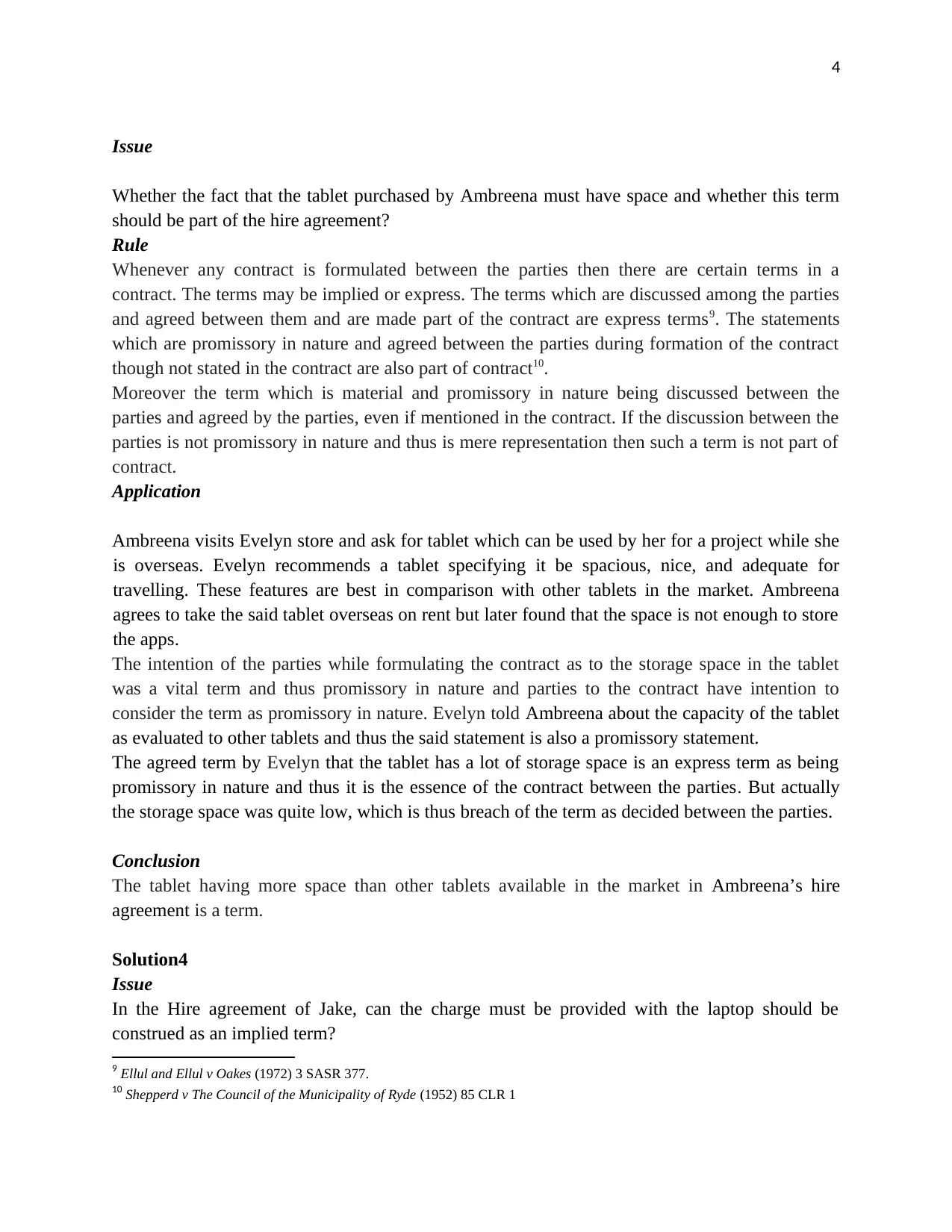
4
Issue
Whether the fact that the tablet purchased by Ambreena must have space and whether this term
should be part of the hire agreement?
Rule
Whenever any contract is formulated between the parties then there are certain terms in a
contract. The terms may be implied or express. The terms which are discussed among the parties
and agreed between them and are made part of the contract are express terms9. The statements
which are promissory in nature and agreed between the parties during formation of the contract
though not stated in the contract are also part of contract10.
Moreover the term which is material and promissory in nature being discussed between the
parties and agreed by the parties, even if mentioned in the contract. If the discussion between the
parties is not promissory in nature and thus is mere representation then such a term is not part of
contract.
Application
Ambreena visits Evelyn store and ask for tablet which can be used by her for a project while she
is overseas. Evelyn recommends a tablet specifying it be spacious, nice, and adequate for
travelling. These features are best in comparison with other tablets in the market. Ambreena
agrees to take the said tablet overseas on rent but later found that the space is not enough to store
the apps.
The intention of the parties while formulating the contract as to the storage space in the tablet
was a vital term and thus promissory in nature and parties to the contract have intention to
consider the term as promissory in nature. Evelyn told Ambreena about the capacity of the tablet
as evaluated to other tablets and thus the said statement is also a promissory statement.
The agreed term by Evelyn that the tablet has a lot of storage space is an express term as being
promissory in nature and thus it is the essence of the contract between the parties. But actually
the storage space was quite low, which is thus breach of the term as decided between the parties.
Conclusion
The tablet having more space than other tablets available in the market in Ambreena’s hire
agreement is a term.
Solution4
Issue
In the Hire agreement of Jake, can the charge must be provided with the laptop should be
construed as an implied term?
9 Ellul and Ellul v Oakes (1972) 3 SASR 377.
10 Shepperd v The Council of the Municipality of Ryde (1952) 85 CLR 1
Issue
Whether the fact that the tablet purchased by Ambreena must have space and whether this term
should be part of the hire agreement?
Rule
Whenever any contract is formulated between the parties then there are certain terms in a
contract. The terms may be implied or express. The terms which are discussed among the parties
and agreed between them and are made part of the contract are express terms9. The statements
which are promissory in nature and agreed between the parties during formation of the contract
though not stated in the contract are also part of contract10.
Moreover the term which is material and promissory in nature being discussed between the
parties and agreed by the parties, even if mentioned in the contract. If the discussion between the
parties is not promissory in nature and thus is mere representation then such a term is not part of
contract.
Application
Ambreena visits Evelyn store and ask for tablet which can be used by her for a project while she
is overseas. Evelyn recommends a tablet specifying it be spacious, nice, and adequate for
travelling. These features are best in comparison with other tablets in the market. Ambreena
agrees to take the said tablet overseas on rent but later found that the space is not enough to store
the apps.
The intention of the parties while formulating the contract as to the storage space in the tablet
was a vital term and thus promissory in nature and parties to the contract have intention to
consider the term as promissory in nature. Evelyn told Ambreena about the capacity of the tablet
as evaluated to other tablets and thus the said statement is also a promissory statement.
The agreed term by Evelyn that the tablet has a lot of storage space is an express term as being
promissory in nature and thus it is the essence of the contract between the parties. But actually
the storage space was quite low, which is thus breach of the term as decided between the parties.
Conclusion
The tablet having more space than other tablets available in the market in Ambreena’s hire
agreement is a term.
Solution4
Issue
In the Hire agreement of Jake, can the charge must be provided with the laptop should be
construed as an implied term?
9 Ellul and Ellul v Oakes (1972) 3 SASR 377.
10 Shepperd v The Council of the Municipality of Ryde (1952) 85 CLR 1
Paraphrase This Document
Need a fresh take? Get an instant paraphrase of this document with our AI Paraphraser
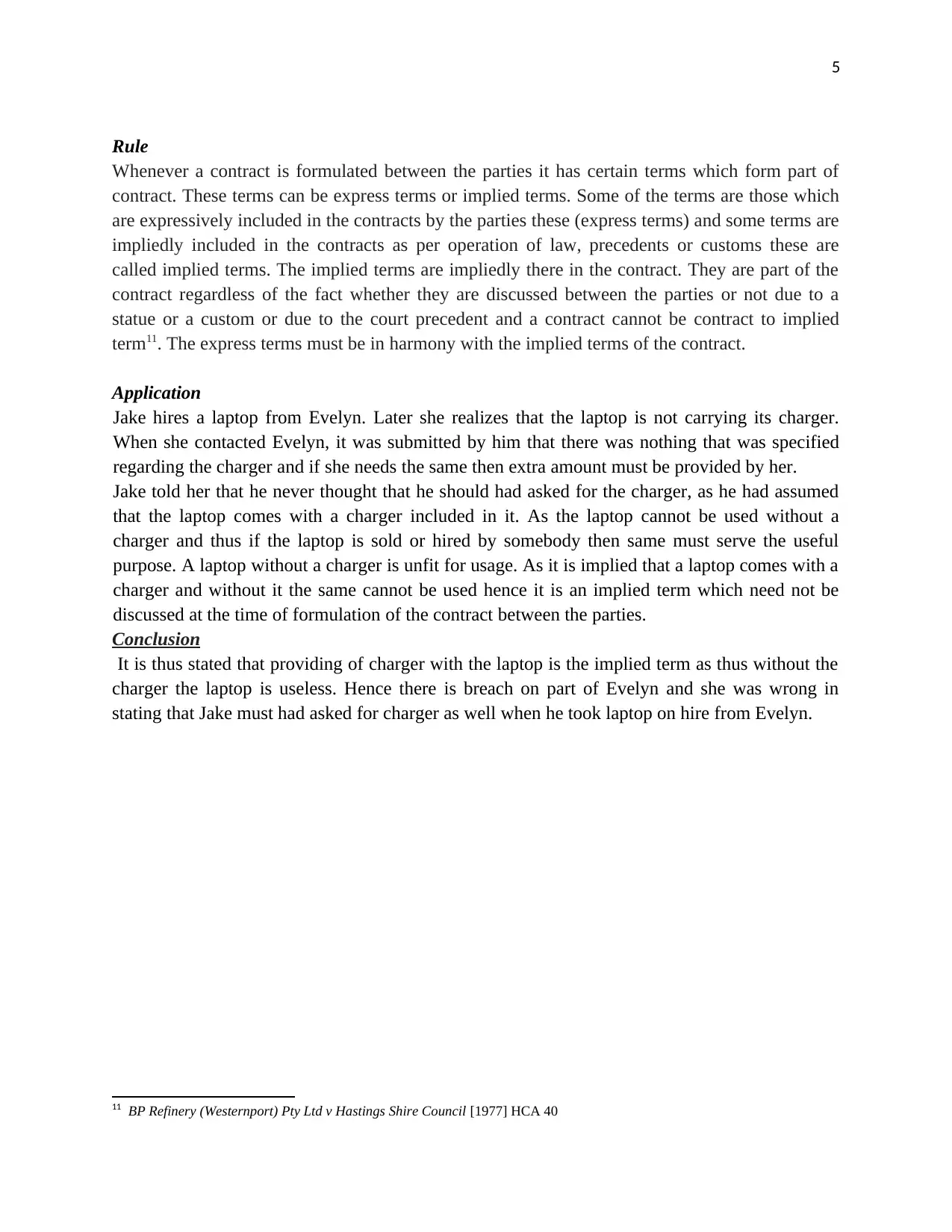
5
Rule
Whenever a contract is formulated between the parties it has certain terms which form part of
contract. These terms can be express terms or implied terms. Some of the terms are those which
are expressively included in the contracts by the parties these (express terms) and some terms are
impliedly included in the contracts as per operation of law, precedents or customs these are
called implied terms. The implied terms are impliedly there in the contract. They are part of the
contract regardless of the fact whether they are discussed between the parties or not due to a
statue or a custom or due to the court precedent and a contract cannot be contract to implied
term11. The express terms must be in harmony with the implied terms of the contract.
Application
Jake hires a laptop from Evelyn. Later she realizes that the laptop is not carrying its charger.
When she contacted Evelyn, it was submitted by him that there was nothing that was specified
regarding the charger and if she needs the same then extra amount must be provided by her.
Jake told her that he never thought that he should had asked for the charger, as he had assumed
that the laptop comes with a charger included in it. As the laptop cannot be used without a
charger and thus if the laptop is sold or hired by somebody then same must serve the useful
purpose. A laptop without a charger is unfit for usage. As it is implied that a laptop comes with a
charger and without it the same cannot be used hence it is an implied term which need not be
discussed at the time of formulation of the contract between the parties.
Conclusion
It is thus stated that providing of charger with the laptop is the implied term as thus without the
charger the laptop is useless. Hence there is breach on part of Evelyn and she was wrong in
stating that Jake must had asked for charger as well when he took laptop on hire from Evelyn.
11 BP Refinery (Westernport) Pty Ltd v Hastings Shire Council [1977] HCA 40
Rule
Whenever a contract is formulated between the parties it has certain terms which form part of
contract. These terms can be express terms or implied terms. Some of the terms are those which
are expressively included in the contracts by the parties these (express terms) and some terms are
impliedly included in the contracts as per operation of law, precedents or customs these are
called implied terms. The implied terms are impliedly there in the contract. They are part of the
contract regardless of the fact whether they are discussed between the parties or not due to a
statue or a custom or due to the court precedent and a contract cannot be contract to implied
term11. The express terms must be in harmony with the implied terms of the contract.
Application
Jake hires a laptop from Evelyn. Later she realizes that the laptop is not carrying its charger.
When she contacted Evelyn, it was submitted by him that there was nothing that was specified
regarding the charger and if she needs the same then extra amount must be provided by her.
Jake told her that he never thought that he should had asked for the charger, as he had assumed
that the laptop comes with a charger included in it. As the laptop cannot be used without a
charger and thus if the laptop is sold or hired by somebody then same must serve the useful
purpose. A laptop without a charger is unfit for usage. As it is implied that a laptop comes with a
charger and without it the same cannot be used hence it is an implied term which need not be
discussed at the time of formulation of the contract between the parties.
Conclusion
It is thus stated that providing of charger with the laptop is the implied term as thus without the
charger the laptop is useless. Hence there is breach on part of Evelyn and she was wrong in
stating that Jake must had asked for charger as well when he took laptop on hire from Evelyn.
11 BP Refinery (Westernport) Pty Ltd v Hastings Shire Council [1977] HCA 40

6
⊘ This is a preview!⊘
Do you want full access?
Subscribe today to unlock all pages.

Trusted by 1+ million students worldwide
1 out of 6
Related Documents
Your All-in-One AI-Powered Toolkit for Academic Success.
+13062052269
info@desklib.com
Available 24*7 on WhatsApp / Email
![[object Object]](/_next/static/media/star-bottom.7253800d.svg)
Unlock your academic potential
Copyright © 2020–2025 A2Z Services. All Rights Reserved. Developed and managed by ZUCOL.

